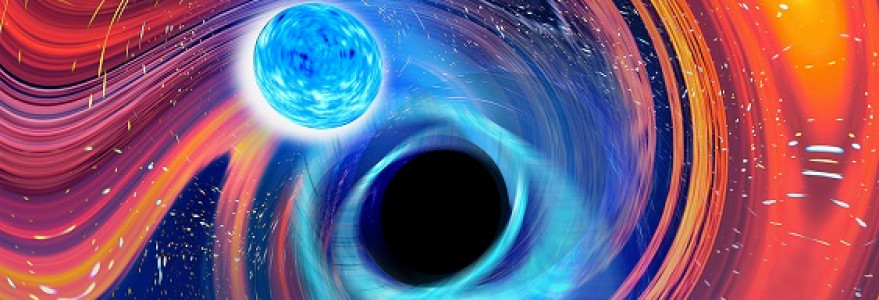Scientists from the UW Astronomical Observatory have contributed to the discovery of binary systems consisting of a black hole and a neutron star (NSBH). The existence of these systems was predicted by astronomers several decades ago, but they had never been observed, either through electromagnetic or gravitational signals, until now. The result and its astrophysical implications have been published in “The Astrophysical Journal Letters”.
Neutron stars are incredibly dense dead stars. They are as massive as the Sun, but they are only several dozens of kilometres in diameter. Black holes are astronomical objects that have such strong gravity, not even light can escape. They come in various sizes, and their masses can vary from a few to about 65 solar masses.
Long-awaited signals
On 5th January 2020, the Advanced Virgo detector in Italy and the Advanced LIGO detector in Livingston in Louisiana, observed a gravitational wave produced by the last few decaying orbits, before the merging, of a NSBH pair. Just ten days later a second gravitational wave signal from the inspiral and merger of a similar binary system, was observed, this time by both Advanced LIGO detectors and the Virgo detector. These two events, nicknamed GW200105 and GW200115 (from the dates of their detection), represent the first observations of gravitational waves generated by a mix of neutron stars and black holes. The existence of these systems was predicted by astronomers several decades ago, but they had never been observed, either through electromagnetic or gravitational signals, until now.
“Since the first spectacular detection of gravitational waves from the binary black holes merger GW150914, for which the Nobel Prize was awarded in 2017, we have detected signals from fifty binary compact objects, but they were only the mergers of two black holes or two neutron stars,” explains Prof. Dorota Rosińska from the Astronomical Observatory of the University of Warsaw.
“Now, it is the first time when a mixed pair was detected. However, Prof. Krzysztof Belczyński and I have predicted such a scenario for twenty years,” adds Prof. Tomasz Bulik from the Astronomical Observatory of the University of Warsaw.
The discovery gives new insights into the complex mechanisms that may have generated these extreme and rare events and, together with the previous Virgo and LIGO detections, begins to shed light on a yet unexplored cosmic landscape.
The gravitational signals detected in January encode valuable information on the physical features of the systems (the mass and distance of the two NSBH pairs), and the physical mechanisms that have generated them and bring them to collapse.
Before the first dinosaurs
The signal analysis has shown that the black hole and neutron star that created GW200105 are, respectively, about 8.9 times and 1.9 times as massive as our Sun, and their merger happened around 900 million years ago, hundreds of millions of years before the first dinosaurs appeared on Earth. For the GW200115 event, the Virgo and LIGO scientists estimate the two compact objects had masses around 5.7 (BH) and 1.5 (NS) times the Sun mass and that they merged almost 1 billion years ago.
The result published on 29th June, alongside the dozens of detections made by Virgo and LIGO to date, allow us, for the first time, to observe some of the most violent and rare phenomena in the Universe and to draw an unprecedented picture of the crowded and chaotic regions that are one of the possible nursery environments of these events. Furthermore, the detailed information we have started to collect about the physics of the black hole and star mergers gives us the chance to test the fundamental laws of physics in extreme conditions, which we will never be able to reproduce on Earth.
More information on the discovery is available on:
Virgo-Polgraw is a Polish team of researchers analysing the data collected by the LIGO and Virgo detectors in search for gravitational waves. Virgo-Polgraw scientists contributed to the recent discovery. Among them were the researchers from the University of Warsaw Astronomical Observatory: Prof. Dorota Rosińska, Prof. Tomasz Bulik, Dr. Przemysław Figura, Dr. Bartosz Idzikowski and doctoral candidates: Małgorzata Curyło, Neha Singh, and Paweł Szewczyk.
Publication details
“Observation of gravitational waves from two neutron star-black hole coalescences”, The LIGO Scientific Collaboration, the Virgo Collaboration, and the KAGRA Collaboration,
“Astrophysical Journal Letters”, 29 June 2021; DOI: 10.3847/2041-8213/ac082e



